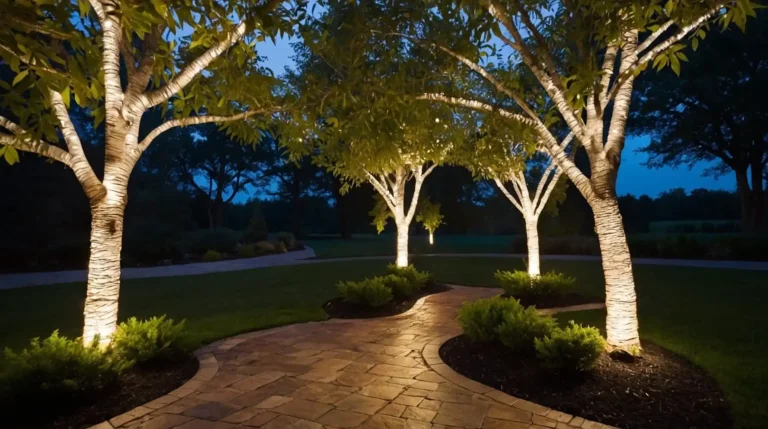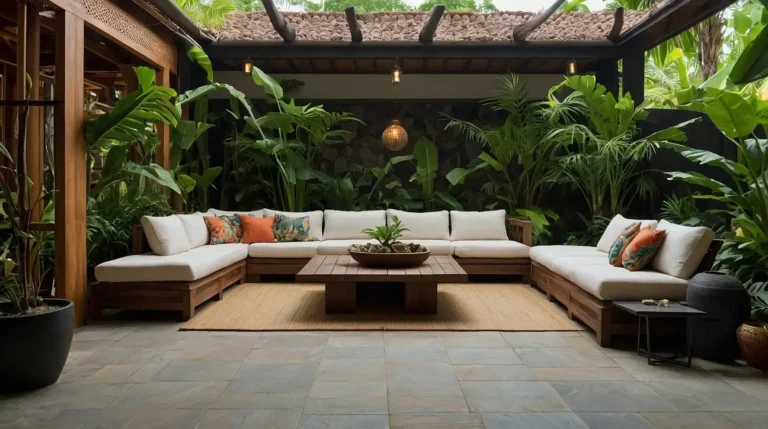17 Enchanting Shade Garden Layout Ideas to Transform Your Outdoor Space
Are you struggling with a shady spot in your yard?
Don’t worry! Shade gardens can be some of the most magical and tranquil spaces in your landscape.
With the right design approach, those shadowy areas can transform into lush retreats filled with texture, color, and interest throughout the seasons.
No more treating those shady spots as problem areas!
Let’s explore 17 creative shade garden layout ideas that will help you embrace and celebrate the cool, peaceful ambiance that shade provides.
1: Layered Woodland Retreat

Create a forest-inspired sanctuary by arranging plants in distinct layers.
Start with a canopy of small trees, then add a middle layer of ferns and hostas, and finish with a groundcover of sweet woodruff or wild ginger.
This natural arrangement mimics woodland growth patterns and creates depth in your garden.
The varied heights will catch filtered light in different ways throughout the day, creating a dynamic space.
2: Curved Path Journey

Install a winding stone or mulch path through your shade garden to create movement and invite exploration.
The curves will naturally slow visitors down, encouraging them to notice the subtle beauties of shade plants.
Position eye-catching plants like Japanese painted ferns or coral bells at curve points to serve as focal points.
This layout transforms a simple garden into an adventure.
3: Rock Garden Elevation

Incorporate large boulders and stones to create level changes in your shade garden.
These natural elements add sculptural interest and create microhabitats for different shade-loving plants.
The rocks will also retain heat, potentially extending your growing season in cooler climates.
Place smaller plants like moss and miniature hostas between rocks for a naturalistic look.
4: Asian-Inspired Tranquility

Design a Japanese-inspired shade garden with carefully placed elements that promote tranquility.
Include a small water feature, Japanese maples, and neatly pruned azaleas or rhododendrons.
Add a simple bench for quiet contemplation and incorporate clean lines with bamboo accents.
The restrained plant palette and thoughtful arrangement will create a meditative atmosphere.
5: Living Wall Vertical Garden

Maximize limited space by growing upward with a living wall system.
Install trellises, wall planters, or specialized vertical gardening systems against fences or walls in shady areas.
Fill with climbing hydrangeas, ferns, and shade-tolerant vines.
This approach not only maximizes growing space but also creates a dramatic backdrop that can hide unsightly boundaries.
6: Secret Garden Room

Create an enclosed garden room using tall shrubs like hydrangeas or rhododendrons as living walls.
Include an entrance arbor covered with climbing vines and a small seating area inside.
This layout provides a sense of discovery and privacy.
Add white or light-colored flowers that glow in the dim light, making the space feel magical and secluded.
7: Hosta Collection Display

Showcase the incredible variety of hostas by creating a dedicated display area.
Arrange different sizes, colors, and leaf patterns for maximum visual impact.
Incorporate a simple color scheme of greens, blues, and whites to create unity.
Add occasional splashes of complementary colors with seasonal bloomers like astilbes or Japanese forest grass for contrast.
8: Moss Garden Sanctuary

Embrace the moist conditions of shade by creating a moss garden.
Establish different types of moss as your primary groundcover and accent with minimal stone elements and small shade perennials.
This low-maintenance approach creates a sense of age and permanence.
The velvety texture of moss invites touch and creates an especially peaceful atmosphere when combined with the sound of trickling water.
9: Tropical Shade Oasis

Create an unexpected tropical retreat using large-leaved plants that thrive in shade.
Combine elephant ears, cast iron plants, and hardy palms with colorful coleus for a bold, exotic feel.
The dramatic leaf sizes and shapes will create movement even without breeze.
This approach works especially well in transitional areas between full shade and partial sun.
10: Monochromatic White Garden

Design a sophisticated white garden that glows in the shade.
Select plants with white flowers and silver or variegated foliage that will capture and reflect what little light is available.
Astilbes, white bleeding hearts, and variegated hostas create an elegant composition.
This layout is especially effective when viewed from inside your home during evening hours.
11: Shade Perennial Border

Create a traditional border adapted for shade conditions.
Place taller plants like foxgloves and delphiniums at the back, mid-height plants like hellebores in the middle, and low-growing plants like heucheras at the front.
This classic layout provides structure and seasonal interest. Incorporate plants with different blooming times to ensure year-round appeal.
12: Fern Gully Collection

Dedicate a space to the incredible variety of ferns available.
Mix textures and forms, from the delicate maidenhair fern to the bold and architectural ostrich fern.
Creating slight berms or depressions will provide varied moisture levels for different fern varieties.
The subtle color variations and distinctive leaf patterns create a soothing, cohesive look.
13: Bistro-Style Retreat

Center your shade garden around a small seating area with a bistro table and chairs.
Surround this focal point with container plants that can be changed seasonally for fresh interest.
This layout creates purpose in your shade garden and encourages you to spend time there.
Position scented plants nearby to enhance the sensory experience as you relax.
14: Native Woodland Recreation

Design a shade garden using only plants native to your region. Research what naturally grows in forested areas near you and recreate that ecosystem in your yard.
This approach supports local wildlife and typically requires less maintenance once established.
The natural associations between plants will create a harmonious, sustainable garden.
15: Shade Edible Garden

Challenge the notion that edible gardens need full sun by creating a shade-tolerant food garden.
Include leafy greens, herbs like mint and chives, and berries such as currants and gooseberries.
Arrange plants according to harvest times and maintenance needs.
This functional layout brings purpose to shady areas while providing fresh produce for your table.
16: Mixed Texture Tapestry

Focus on foliage by creating a garden that highlights different leaf textures and forms.
Combine feathery ferns with smooth hostas, spiky astilbes, and heart-shaped wild gingers.
This approach creates interest without relying on flowers.
The varied textures catch light differently, creating subtle highlights and shadows that change throughout the day.
17: Water Feature Focal Point

Center your shade garden around a water feature like a small pond or fountain.
The sound of water adds another sensory dimension, while the reflective surface bounces light into shadowy areas.
Surround with moisture-loving plants like Japanese iris and cardinal flower.
This layout creates a natural gathering spot and can attract beneficial wildlife to your garden.
Conclusion
Your shade garden doesn’t have to be an afterthought.
With these layout ideas, you can transform those challenging spots into the most enchanting spaces in your landscape. Start planning your shade sanctuary today!







